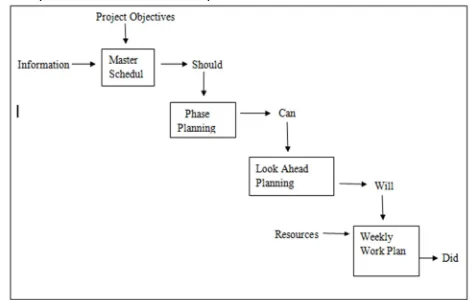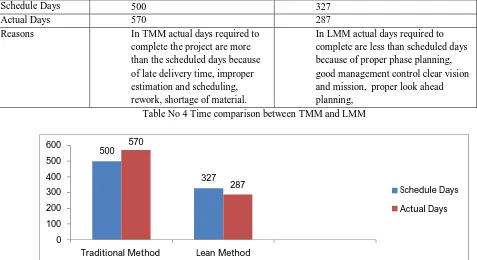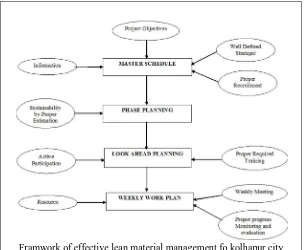The Study of Lean Method for Material
Management in Construction Project by Time and
Cost Analysis: Case Study at Kolhapur
Ms. Arpita Bharat Nikam1, Mr. Satyajit B patil.2 2
Assistant Professor, 1M.Tech Student, Department of civil engineering, Ashokrao Mane Group of Institution, Vathar tarf Vadgaon, Kolhapur
Abstract: One approach for improving the current construction industry situation is using lean construction. Lean construction results from the application of a new form of production management to construction. Lean based tools have emerged and have been successfully applied to simple and complex construction projects. In general, lean construction projects are easier to manage, safer, completed sooner, and cost less and are of better quality. So, it is important to each and every where the lean material management should be used in construction project to reduce costs and time of construction project and increase the effectiveness. This study conduct one case study in Kolhapur where, consider one site on which we apply the lean material management. After that result obtain in the form of estimated cost vs. scheduled cost, estimated time vs. scheduled time. This result compare with traditional method which conduct in past. The lean result compare with traditional result and comparison are shown.
Keywords: Material Management, Lean Construction, Construction waste, construction material, Construction Project.
I. INTRODUCTION
The productivity of the construction industry worldwide has been declining over the past years. Lean construction results from the application of a new form of production management to construction. Essential features of lean construction include a clear set of objectives for the delivery process, aimed at maximizing performance for the customer at the project level, concurrent design, construction, and the application of project control throughout the life cycle of the project from design to delivery. The Last Planner System technique, which is an important application of the lean construction concepts and methodologies and is more prevalent, proved that it could enhance the construction management practices in various aspects. Also, it is intended to develop methodology for process evaluation and define areas for improvement based on lean approach principles.
In proposed study approach included main study targeting purposively selected construction professionals respondent, in the Kolhapur city. First of all questionnaire was designed with the help of guide and experts in respective fields. Then responses are collected and respective objectives are obtained. From the questionnaire the factors affecting on lean material management application for Kolhapur city are find out. After that comparison between the traditional method and lean method take to find out the wastage of cost and time.
This study conduct one case study where, consider one site on which we apply the lean material management. After that result obtain in the form of estimated cost vs. scheduled cost, estimated time vs. scheduled time. This result compare with traditional method where the case study taken. The lean result compare with traditional result and comparison are shown. The new framework of Lean Material Management for Kolhapur is developed with reducing the factors which affected on implementation.
A. Lean Construction
A ‘lean’ system/ process/ organization is one that is waste free. Lean is not about size or number of people employed. A reduction in employees may cut costs, and eliminate the waste of those employees, but does not decrease the proportion of waste to value adding within the organization or process. Waste is through products waiting to be worked on by succeeding activities.
B. Techniques Available in Lean Material Management
quality. This tool is similar to the lean manufacturing tool, Visual Controls, which is a continuous improvement activity that relates to the process control.
2) 5 ’S’ Technique: It helps to identify the location of material, equipment, and access, which reduced waste, such as search time for material and lay down spaces, and waiting time. This can be achieved by 5s process. It include sort, set in order, shine, standardize, sustain.
3) Standard Work Method: SWM is the Foundation of Lean. It is the safest, highest quality, and most efficient way known to perform a particular task and process. It is the only acceptable way to do the task and process which should be continually improved. It includes three critical elements that are customer demand. SWM includes following steps :-Define start and end points of the process, Determine appropriate standard work, Gather required information, Create standard work documents, train the supervisor, Train employees, Run the process and observe results
4) 7 Wastage Method: The things produced more than necessity are nothing but wastes; the main of lean is to reduce waste.So it is necessary to reduce waste produced due to defects, overproduction, transportation, movement, waiting, overproduction, inventory etc. Non value added work
C. Last Planner System
Last planner system is combination of all methods discussed above. It includes all the point in all above methods. So lean material management doing on site by mostly using Last Planner System, which discussed deeply in below.
[image:2.612.67.542.405.705.2]1) Last Planner System: The Last Planner System used for Planning and mutual coordination.The Last Planner System (LPS), the main tool of Lean Construction, is a collaborative planning tool facilitating communication, participation and which take into consideration the constraints of each stakeholder. The last planner system is in simple word it is the combination of all above mentioned tools. It has the main objectives such as manage and mitigate the variability, the completed assignments should be checked, causes to failure to complete the planned work should be investigated and removed etc. Last Planner System (LPS) aims to shift the focus of control from the workers to the flow of work that links them together. The two main objectives of LPS are to make better assignments to direct workers through continuous learning and corrective action and to cause the work to flow across production units in the best achievable sequence and rate.
II. METHODOLOGY
This chapter describes the methodology that has been adapted in the present thesis. The study will be carried out in Kolhapur, Maharashtra as per availability of data and sites. First of the entire all literature related to the lean material management are studied. Which explain the lean and its various techniques. After that one of the most important techniques is selected. Then it is implemented on the site which gives the result. Then the conclusion and necessary recommendation are given.
LITERATURE REVIEW
IMPLIMENTATIONS
RESULTS AND DISCUSSIONS
CONCLUSIONS AND RECOMMENDATIONS
Fig.2 research Methodology
III. IMPLIMENTATION
In this chapter we are discussed that most using method of lean that is Last Planner System which is how apply on the Kolhapur city, and the factors affecting on that calculated, how to minimize them by developing new frame work of lean material management for Kolhapur city .
A. Case study for Traditional Material Management
To compare the lean material Management with traditional material management, we take one construction site for the same company under which we work out lean material management.
1) Details OF Site: The Construction site where the traditional material management was conducted are given below, it is residential building of G+1 of 3291.31 sq.ft. Total built up area.
1 PROJECT TYPE Residential project (G+1)
2 SCHEDULED COST 4282628.94
3 ACTUAL COST 4531452.60
4 SCHEDULED DAYS 500
[image:3.612.56.551.439.523.2]5 ACTUAL DAYS 570
Table No. 1 Traditional material management
B. Case study for lean material management
SR. NO
CATEGORY PHASE
NO
CONTENT ACTUAL
TIME(DAYS)
SCHEDULED TIME (DAYS)
COST
1 Line out 5 5 19610
2 Ground Floor 1 Foundation 30 32 131250
2 Column 25 28 71500
3 Beam 25 30 88800
4 Slab 31 30 165500
5 Staircase 5 6 60700
6 Brickwork 12 15 74750
7 Plasterwork 12 15 64500
3 First Floor 8 Column 22 28 71500
9 Beam 25 25 88800
10 Slab 31 30 165500
11 Staircase 5 5 60700
12 Brickwork(including
chajja work)
12 14 154750
13 Plasterwork 12 15 64500
4. Parapet Wall 14 6 8 64250
4. Tile Placing 15 25 35 184882
5. Door, Window
placing
16 4 6 181680
[image:4.612.51.566.76.399.2]Total 287 327
Table No 2 Lean material management with cost and time
1) Hence, from the all calculation the observation obtained are given below,
2) The total cost (plumbing, elevation, electrification) of construction as per lean construction = 1918752.64/-
3) The total cost of construction as per schedule = 2237670.79/-
4) The scheduled days as per traditional method = 327 days
5) The days required as per lean construction are = 287 days
IV. RESULT
It will show the cost and time comparison of lean material management and traditional material management.
1) Cost Comparison: Cost comparison shown between Traditional Method Lean Method and The reasons responsible for that are also shown below
Cost Traditional Method (TMM) Lean Method
Schedule Cost 4282628.94 2237670.79
Actual Cost 4531452.6 1918752.64
Reasons In TMM the Actual cost was more than scheduled cost. Due to the improper estimation, scheduling. Improper planning, Poor management control, Shortage of resources, Lack of team work.
In LMM the Actual cost was less than scheduled cost. Due the proper scheduling and estimation, Proper phase planning, management control till the end.
[image:4.612.68.541.567.702.2]Fig.No.3: Cost comparison between TMM and LMM
2) Time Comparison: Time comparison shown between Traditional Method Lean Method and The reasons responsible for that are also shown below,
Days Traditional Method (TMM) Lean Method(LMM)
Schedule Days 500 327
Actual Days 570 287
Reasons In TMM actual days required to
complete the project are more than the scheduled days because of late delivery time, improper estimation and scheduling, rework, shortage of material.
[image:5.612.70.547.273.533.2]In LMM actual days required to complete are less than scheduled days because of proper phase planning, good management control clear vision and mission, proper look ahead planning,
Table No 4 Time comparison between TMM and LMM
Fig.No.4: Time comparison between TMM and LMM
V. CONCLUSION
The learning outcome from the study , here we give the solution on the factor which are affect on lean material management for Kolhapur city and design new frame work for Kolhapur city which is the main aim. The solution given on traditional material management which is lean is effectively successful which reduce the cost and time wastage which is the important. The study can be extended to find out various types of construction waste been produced in construction industries and to implement various types of lean techniques in order to minimize waste and decrease the impact of waste on Cost, Quality and Time.
After studying the it was concluded that
A. Application of last planner system gives better results as compare to traditional construction management on case study.
B. It saving of 12.23% and 14% in time and cost respectively.
C. Saving cost 318918.15 Rs. after the application of LPS.
D. Last planner system is more effective than the traditional management system.
42 82 6 2 8 .9 4 2 23 76 7 0. 7 9 45 31 4 5 2 .6 0 1 91 87 5 2. 6 4 0.00 1000000.00 2000000.00 3000000.00 4000000.00 5000000.00
Traditional Method Lean Method
Schedule Cost Actual Cost 500 327 570 287 0 100 200 300 400 500 600
Traditional Method Lean Method
Schedule Days
The frame work used in lean material management for Kolhapur city was,
[image:6.612.155.459.89.339.2]Framwork of effective lean material management fo kolhapur city Table No 5 Framework of effective material management for Kolhapur city
REFERENCES
[1] Lean Construction Techniques in Indian Construction Industry: Some Analysis, ISSN 2278-3652 Volume 7, Number 1 (2016), pp. 59-65.
[2] Analyzing Material Management Techniques on Construction Project, Ashwini R. Patil, Smita V. Pataskar, (IJEIT) Volume 3, Issue 4, October 2013. [3] The Impact of Material Management on Construction Project Delivery In Maldives, Zaha Ahmed.
[4] Lean Construction Techniques in Indian Construction Industry: Some Analysis, ISSN 2278-3652 Volume 7, Number 1 (2016), pp. 59-65.




